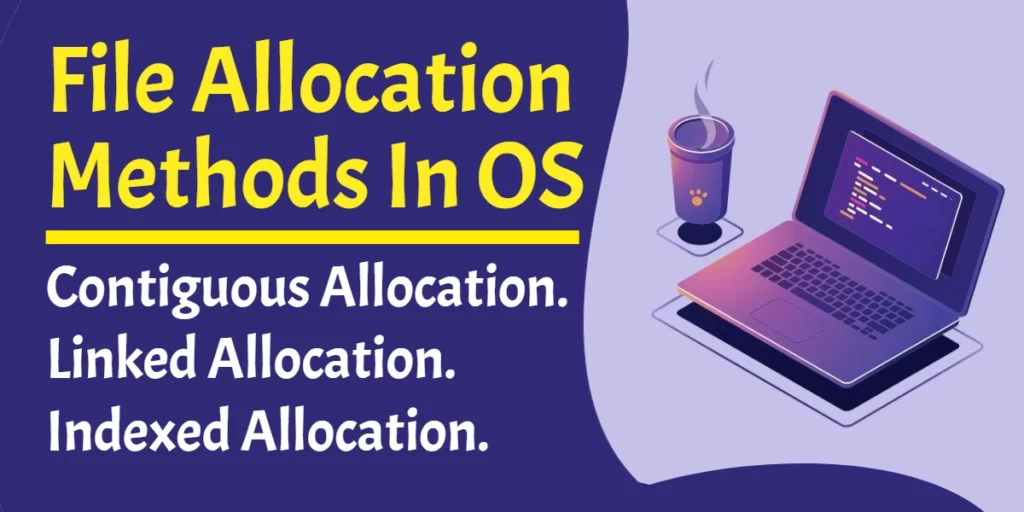In this operating system in-depth article, we will see, how data is stored in secondary storage. In file management, the most important aspect is how and in what way space is allocated for files, so that disk space is effectively utilized, and file access is quick. For this, we will study the following three methods of file allocation:
- Contiguous Allocation.
- Linked Allocation.
- Indexed Allocation.
In the upcoming discussion of this article, We will explore the details of file allocation methods – an important aspect of file management. The primary objective of studying these methods is to understand how data is effectively stored in secondary storage. This knowledge helps use disk space well and makes files open faster. We will explore three key file allocation methods: Contiguous Allocation, Linked Allocation, and Indexed Allocation.
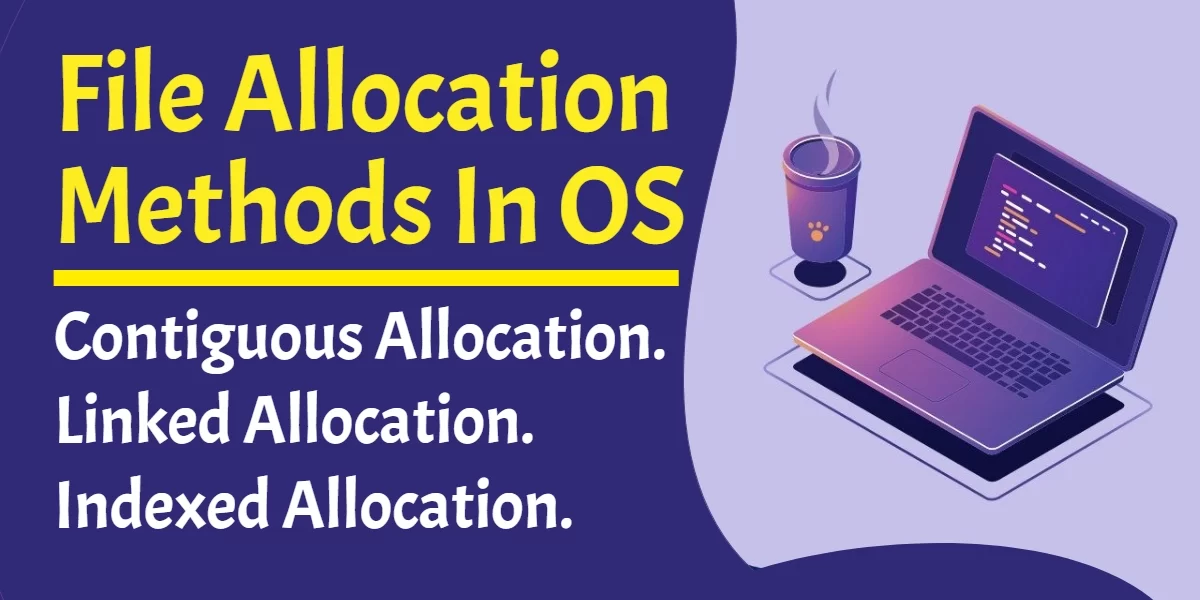
Table of Contents
ToggleContiguous File Allocation Method:
In the Contiguous File Allocation method, each file is allocated consecutive blocks one after another. For example, if each block on the disk is 512 bytes in size, and the file to be stored is 2000 bytes, it would require allocating a total of four consecutive blocks.
This allocation method is essential for efficient disk space utilization. In the file’s directory entry table (FDET), critical information is recorded, including the file’s name, the starting block, and the total allocated blocks. Below, you can see an example where three different files are considered.
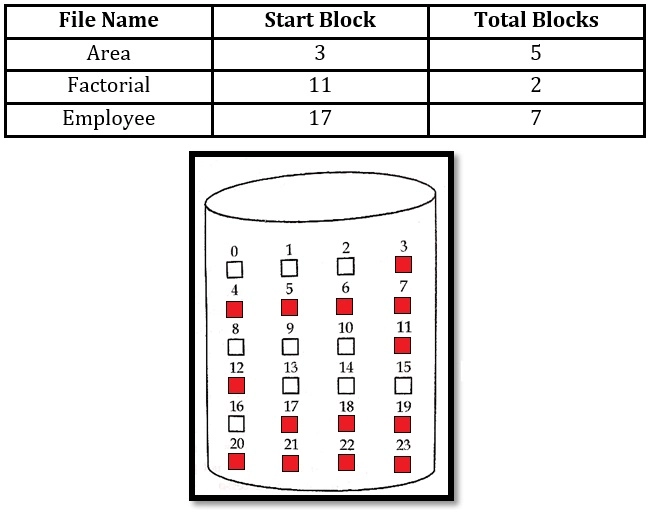
As you can observe in the above table and on the disk, the File ‘Area‘ utilizes the Contiguous File Allocation method by consecutively occupying five blocks with a starting block at 3.
On the other hand, the File ‘Factorial‘ uses a different approach, occupying two consecutive blocks starting from block 11.
Lastly, the File ‘Employee’, starting at block 17, employs a sequential or direct method by consecutively occupying seven blocks. Consequently, both serial and direct access can be used to retrieve these files in the File System in OS, which falls under the broader categories of File Management and Disk Management.
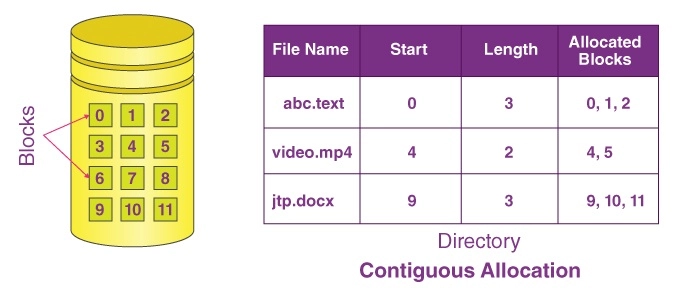
Advantages of Contiguous File Allocation Method:
The Contiguous File Allocation method offers several advantages that make it a suitable choice for certain scenarios. One of the primary benefits is speed and efficiency. Retrieving data from a contiguous allocation is fast because the entire file is stored in one continuous block. This means there is minimal disk head movement, resulting in quicker access times.
Additionally, the simplicity of this method means there is less overhead in managing file allocation, which can be particularly advantageous for smaller systems or devices with limited resources.
Furthermore, it reduces the fragmentation of files on the disk, ensuring that space is used efficiently. This allocation method is well-suited for systems that require speedy, sequential access to data, such as video or audio streaming applications.
Disadvantages of Contiguous File Allocation Method:
While the Contiguous File Allocation method has its merits, it also comes with certain disadvantages. One of the most significant drawbacks is inflexibility. Once a file is allocated a contiguous block, that space cannot be used for any other purpose until the entire file is deleted, even if the file is much smaller than the allocated space. This leads to inefficient use of storage.
External Fragmentation: In the Contiguous File Allocation method, when you delete a file, the space it occupied becomes free. However, this space cannot be reused efficiently, much like what we’ve learned in memory management. The result is external fragmentation, where free spaces are scattered throughout the disk and can’t be utilized effectively. As more files are created and deleted, this fragmentation can lead to wasted disk space.
Internal Fragmentation: In this method, if a file’s size is not an exact multiple of the block size (e.g., 1000 bytes allocated in two 512-byte blocks), it leads to internal fragmentation. Essentially, some space within the allocated blocks remains unused. For example, in a two-block allocation for a 1000-byte file, 24 bytes would be left unused in the second block, contributing to inefficient storage utilization.
Algorithms: Similar to what we’ve learned in memory management, various algorithms such as First Fit, Best Fit, and Worst Fit are used to address these issues in file allocation. These algorithms help determine the most suitable way to allocate space for files, optimizing disk usage and minimizing fragmentation.
Moreover, as files are continuously added and deleted, the disk becomes increasingly fragmented. This fragmentation can result in wasted space, as it becomes challenging to find a large enough block to allocate a new file.
Additionally, the Contiguous File Allocation method is not ideal for systems with varying storage requirements, where files can grow or shrink over time. This method is more suitable for fixed-size, read-only systems where predictability and speed are paramount.
Linked File Allocation Method:
The Linked File Allocation method offers a solution to some of the problems encountered in Contiguous Allocation. In this method, each allocated block contains a pointer (address) to the next block. Typically, a 4-byte pointer is required for the address, which means that if a block size is 512 bytes, the user effectively has 508 bytes of usable space in that block. The last block contains a ‘Null pointer’ (zero address) or an end address.
In this method, the directory entry stores the file’s name and the address of the first block. Unlike Contiguous Allocation, there’s no need to know the file’s size before allocating space because, in Linked Allocation, each file is allocated one block at a time, and the next block can be allocated elsewhere.
The key advantage of this method is that it allows for dynamic file sizes. However, it’s essential to note that direct access isn’t possible in Linked Allocation. Instead, sequential access is employed, meaning files are accessed in sequence. The use of pointers in this method enables a flexible approach to space allocation and accommodates varying file sizes.
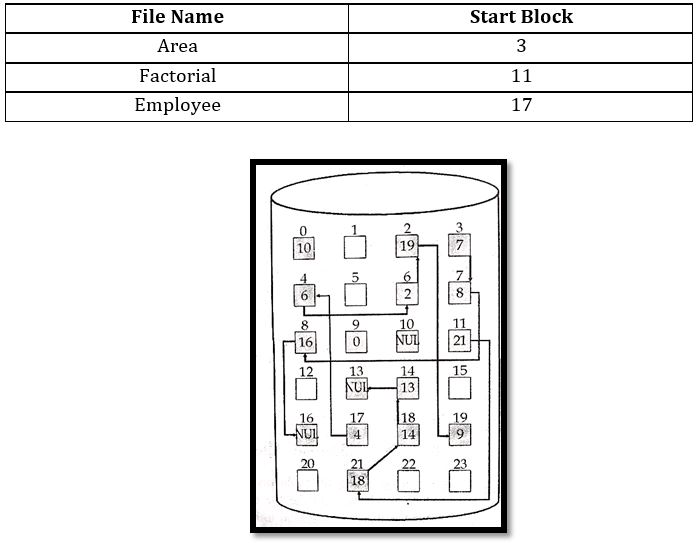
Advantages of Linked File Allocation Method:
Dynamic File Sizes: One of the significant advantages of the Linked File Allocation method is its ability to handle dynamic file sizes. Unlike some other allocation methods that require prior knowledge of a file’s size, linked allocation allows for flexible allocation, enabling users to store files of varying sizes without wasting space.
No External Fragmentation: Linked allocation eliminates the problem of external fragmentation. Since files can be allocated in a non-contiguous manner, it prevents the formation of small, unusable gaps between files. This efficient use of space can be especially beneficial when dealing with a wide range of file sizes.
Ease of Deletion: When a file is deleted in the linked allocation method, the associated blocks are returned to the pool of free blocks, reducing any wasted space. This efficient space reclamation is a practical advantage in terms of disk management.
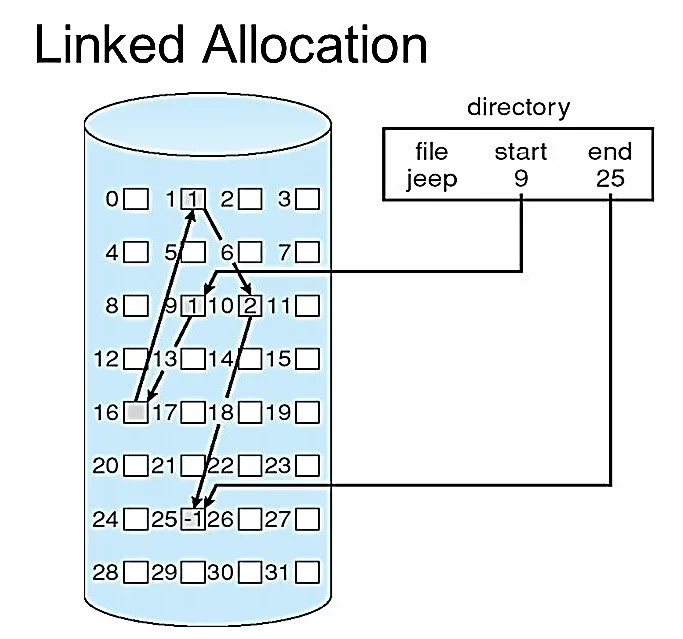
Disadvantages of Linked File Allocation Method:
Lack of Direct Access: Unlike other allocation methods that allow for direct access to a file’s contents, linked allocation necessitates sequential access. To read a specific portion of a file, the system must start from the beginning and work sequentially through each block, which can be inefficient for certain operations.
Overhead: Each block in the linked allocation method carries additional overhead in the form of pointers to the next block. This added data consumes space and can become significant when dealing with numerous small files.
Fragmentation within Blocks: Linked allocation can suffer from internal fragmentation within the blocks. For example, if a file size isn’t an exact multiple of the block size, the final block allocated to the file might not be fully utilized, leading to internal fragmentation.
Indexed File Allocation Method:
In the Indexed File Allocation Method, each file is allocated an additional block known as the “index block.” This block contains the addresses of all the allocated data blocks for that file. For example, if a file is allocated a certain number of data blocks, there will be a corresponding number of entries in the index block.
This method offers the advantage of enabling quick and direct access to specific data blocks. Since the index block holds the addresses, you can easily access any block without having to traverse the file sequentially. Furthermore, you can allocate data blocks to a file without needing to know the file’s size beforehand.
In the directory entry, essential information is stored, including the file’s name, the starting block, and the address of the index block. This arrangement allows for efficient direct access, as all the block addresses are available within the index block.
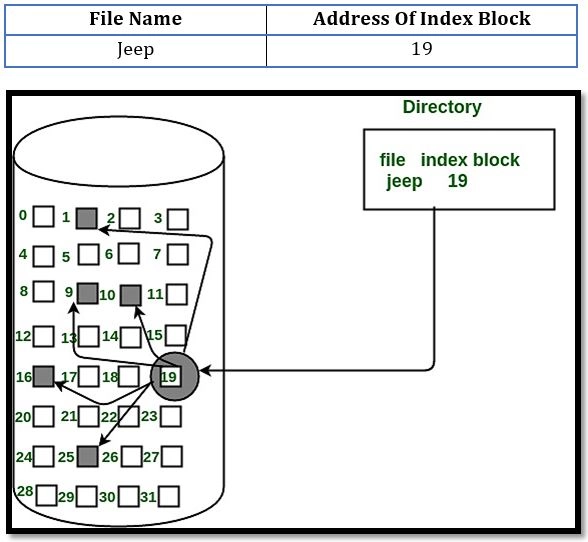
Advantages of Indexed File Allocation Method:
Direct Access: Indexed allocation provides direct access to specific blocks within a file. Since the index block stores the addresses of all allocated blocks, it allows for efficient random access to any part of the file without the need to traverse it sequentially.
No External Fragmentation: Similar to the linked allocation method, indexed allocation avoids external fragmentation by allocating blocks non-contiguously. It effectively utilizes disk space and minimizes wasted storage, especially for varying file sizes.
Efficient Space Management: When a file is deleted, the entire index block associated with it can be quickly returned to the pool of free blocks. This contributes to efficient disk space management.
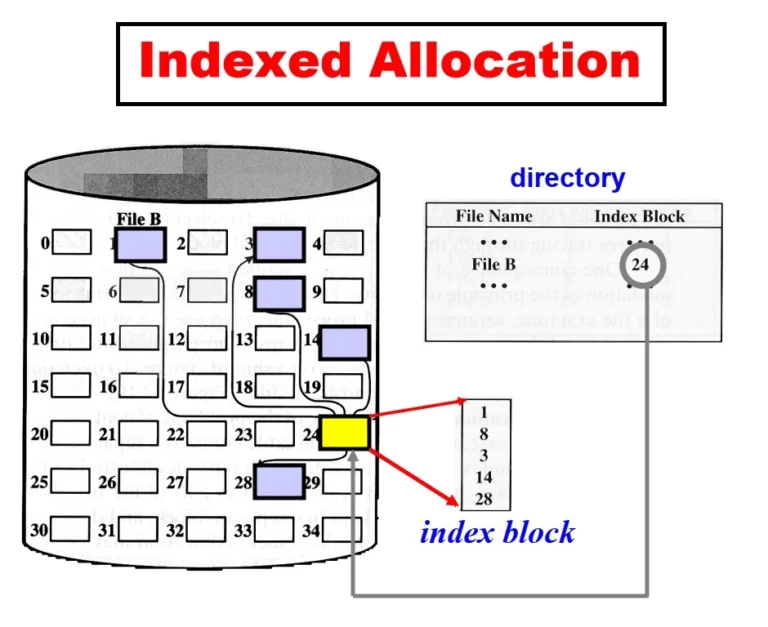
Disadvantages of Indexed File Allocation Method:
Overhead: The indexed allocation method introduces overhead due to the inclusion of an index block for each file. These additional data structures consume disk space, which can become a concern when managing a large number of small files.
Complexity: Indexed allocation requires more complex file management compared to contiguous or linked allocation methods. Managing the index blocks and associated pointers can be challenging, particularly when files are frequently created and deleted.
Limited Disk I/O: While indexed allocation offers direct access, it may lead to an increased number of disk I/O operations when accessing multiple small files. This can potentially affect system performance.
FAQ'S Related To File Allocation Methods In OS
What are File Allocation Methods in Operating Systems?
- File Allocation Methods in Operating Systems define how files are stored on disk drives.
2. What is Contiguous Allocation?
- Contiguous Allocation is a file allocation method where a file is stored in a single, continuous block of disk space.
3. What is Linked Allocation?
- Linked Allocation is a file allocation method where each file is a linked list of data blocks scattered all over the disk.
4. What is Indexed Allocation?
- Indexed Allocation is a file allocation method where a separate index block contains addresses to data blocks for each file.
5. What are the advantages of Contiguous Allocation?
- Advantages of Contiguous Allocation include simple management and faster access times.
6. What are the disadvantages of Contiguous Allocation?
- Disadvantages include inefficient space usage and difficulties in resizing files.
7. How does Linked Allocation manage files?
- Linked Allocation manages files using a linked list structure.
8. What are the advantages of Linked Allocation?
- Advantages include efficient space utilization and easy file allocation.
9. What are the disadvantages of Linked Allocation?
- Disadvantages include slow access times and complex maintenance.
10. How does Indexed Allocation work? –
- Indexed Allocation uses an index block containing addresses to data blocks for each file.
11. What are the advantages of Indexed Allocation? –
- Advantages include fast access times and efficient space usage.
12. What are the disadvantages of Indexed Allocation? –
- Disadvantages include the overhead of maintaining the index block.
13. How does Contiguous Allocation affect disk fragmentation? –
- Contiguous Allocation can lead to external fragmentation.
14. Does Linked Allocation suffer from fragmentation? –
- No, Linked Allocation does not suffer from fragmentation issues.
15. What is the primary concern with Indexed Allocation? –
- The main concern with Indexed Allocation is the overhead of managing the index block.
16. How does Contiguous Allocation simplify file access? –
- Contiguous Allocation simplifies file access by allowing direct access to the entire file.
17. Why is Linked Allocation suitable for sequential access? –
- Linked Allocation is ideal for sequential access because of its linked list structure.
18. Can Linked Allocation handle random access efficiently? –
- No, Linked Allocation is not well-suited for random access.
19. Why is Indexed Allocation great for random access? –
- Indexed Allocation is excellent for random access because it uses an index block.
20. Which Allocation method is suitable for large files? –
- Contiguous Allocation is suitable for large files.
21. Which Allocation method is suitable for small files? –
- Linked Allocation is better for small files.
22. How does Contiguous Allocation perform when files are frequently created and deleted? –
- Contiguous Allocation may lead to fragmentation when files are frequently created and deleted.
23. What kind of data structure does Linked Allocation use? –
- Linked Allocation uses a linked list data structure.
24. What data structure is central to Indexed Allocation? –
- The central data structure for Indexed Allocation is the index block.
25. How does Contiguous Allocation simplify file allocation? –
- Contiguous Allocation simplifies file allocation by placing files consecutively on disk.
26. What is the key challenge in managing Linked Allocation? –
- The main challenge in managing Linked Allocation is dealing with scattered data blocks.
27. How does Indexed Allocation improve disk space utilization? –
- Indexed Allocation enhances disk space utilization through its indexing mechanism.
28. What is the primary benefit of using Contiguous Allocation? –
- The primary benefit of Contiguous Allocation is fast access times.
29. In which Allocation method is file access the slowest? –
- Linked Allocation often results in the slowest file access times.
30. How does Indexed Allocation impact disk I/O? –
- Indexed Allocation reduces disk I/O due to its efficient indexing.
31. What is the risk of data loss in Contiguous Allocation? –
- Data loss risk in Contiguous Allocation is low since files are stored together.
32. What happens if a block in Linked Allocation is damaged? –
- If a block is damaged in Linked Allocation, it can lead to data loss in the entire file.
33. Can you defragment files in Indexed Allocation? –
- Indexed Allocation doesn’t require defragmentation.
34. How is space allocation managed in a Contiguous Allocation? –
- Space allocation in Contiguous Allocation is managed by marking used blocks as occupied.
35. What is the primary reason for space efficiency in Linked Allocation? –
- Space efficiency in Linked Allocation is achieved by allocating only the required blocks for a file.
36. Why is Contiguous Allocation not suitable for a dynamic environment? –
- Contiguous Allocation doesn’t adapt well to a dynamic environment due to its rigid space allocation.
37. What is the main advantage of the Linked Allocation method? –
- The main advantage of Linked Allocation is that it doesn’t suffer from fragmentation.
38. How does Indexed Allocation enhance the reliability of data storage? –
- Indexed Allocation enhances data reliability as data blocks are individually indexed.
39. What happens if an entry in the index block is lost in Indexed Allocation? –
- If an entry is lost, it can make accessing specific blocks of a file difficult in Indexed Allocation.
40. Can files be extended easily in a Contiguous Allocation? –
- Extending files in Contiguous Allocation can be challenging and may require moving the entire file.
41. What is the minimum storage unit allocated in Linked Allocation? –
- The minimum storage unit allocated in Linked Allocation is a single block.
42. What is the minimum storage unit allocated in Indexed Allocation? –
- The minimum storage unit allocated in Indexed Allocation is a single block for file data and an index block.
43. What happens if the index block is lost in Indexed Allocation? –
- If the index block is lost, it becomes nearly impossible to access any part of the file.
44. How is data integrity maintained in a Contiguous Allocation? –
- Data integrity is typically maintained in Contiguous Allocation due to the continuous storage of files.
45. How does Linked Allocation handle data storage for large files? –
- Linked Allocation handles data storage for large files efficiently.
46. How does Indexed Allocation minimize external fragmentation? –
- Indexed Allocation minimizes external fragmentation by using an index block.
47. How does Linked Allocation handle disk space utilization? –
- Linked Allocation maximizes disk space utilization.
48. What is the main concern with Linked Allocation? –
- The main concern with Linked Allocation is the overhead of managing linked lists.
49. What are the characteristics of Contiguous Allocation that make it efficient for some applications? –
- Contiguous Allocation is efficient when you have large files that require minimal modification.
50. What type of file system commonly uses Indexed Allocation? –
- Indexed Allocation is commonly used in file systems like NTFS to optimize data storage and retrieval.
MCQ'S Related To File Allocation Methods In OS
Basic File Allocation Methods In Operating System:
What is a file allocation method?
- a) A method for securing files.
- b) A technique for organizing files on a disk.
- c) A way to delete files.
- d) A method for compressing files.
Answer: b
Which of the following is a basic file allocation method?
- a) Indexed Allocation.
- b) Database Management.
- c) Linked Allocation.
- d) Contiguous Allocation.
Answer: d
What problem does file allocation method address?
- a) Data encryption.
- b) File storage and organization.
- c) Hardware maintenance.
- d) Network connectivity.
Answer: b
Which file allocation method allows files to be stored in consecutive blocks on the disk?
- a) Contiguous Allocation.
- b) Linked Allocation.
- c) Indexed Allocation.
- d) Non-contiguous Allocation.
Answer: a
In which allocation method are files connected through a linked list structure?
- a) Contiguous Allocation.
- b) Linked Allocation.
- c) Indexed Allocation.
- d) Non-contiguous Allocation.
Answer: b
Contiguous Allocation:
In Contiguous Allocation, how are files stored on the disk?
- a) Scattered across the disk.
- b) In separate blocks.
- c) In a single continuous block.
- d) Using a linked list structure.
Answer: c
What is one disadvantage of Contiguous Allocation?
- a) Efficient space usage.
- b) Difficulty in resizing files.
- c) Fast access times.
- d) No risk of fragmentation.
Answer: b
How does Contiguous Allocation impact disk fragmentation?
- a) It eliminates fragmentation.
- b) It leads to external fragmentation.
- c) It improves file access.
- d) It increases disk speed.
Answer: b
Which term describes the inefficient use of space caused by Contiguous Allocation?
- a) Data loss.
- b) Fragmentation.
- c) Compression.
- d) Encryption.
Answer: b
What happens when a file is deleted in Contiguous Allocation?
- a) Space is reclaimed for later use.
- b) Data is lost.
- c) The file is compressed.
- d) The file is encrypted.
Answer: a
Linked Allocation:
What is the primary advantage of Linked Allocation?
- a) Fast access times.
- b) Efficient space utilization.
- c) Reduced disk fragmentation.
- d) Large storage capacity.
Answer: b
What is the primary disadvantage of Linked Allocation?
- a) Data security issues.
- b) Slow access times.
- c) No space allocation flexibility.
- d) Compatibility problems.
Answer: b
Which file system uses Linked Allocation for some of its file structures?
- a) FAT32.
- b) Ext3.
- c) NTFS.
- d) HFS+.
Answer: c
In Linked Allocation, how are files managed?
- a) Using a contiguous block.
- b) By dividing files into equal parts.
- c) By maintaining a linked list structure.
- d) By compressing the files.
Answer: c
What term describes the efficient use of space in Linked Allocation?
- a) Data encryption.
- b) Fragmentation.
- c) Clustering.
- d) Data blocks.
Answer: c
Indexed Allocation:
In Indexed Allocation, what is an “Index Block”?
- a) A block that contains a list of file names.
- b) A block that directly stores data.
- c) A block that points to other blocks containing file addresses.
- d) A block reserved for system files.
Answer: c
What is the primary advantage of Indexed Allocation?
- a) Fast access times.
- b) Reduced disk fragmentation.
- c) Simple file deletion.
- d) Efficient space utilization.
Answer: a
In Indexed Allocation, how does the index block improve file access?
- a) It increases the file’s size.
- b) It reduces the number of required disk accesses.
- c) It compresses the file.
- d) It encrypts the file.
Answer: b
What type of file system typically employs Indexed Allocation?
- a) FAT16.
- b) NTFS.
- c) Ext2.
- d) HFS.
Answer: b
What is the primary disadvantage of Indexed Allocation?
- a) Slow access times.
- b) Efficient space utilization.
- c) Limited storage capacity.
- d) Data loss issues.
Answer: a
Article Basic FAQS
1. File Allocation Methods In OS:
Q1. What are file allocation methods in an operating system?
- A file allocation method in an operating system determines how files are stored on storage devices like hard drives. It specifies the rules and structures for managing file data.
Q2. Why are file allocation methods important in OS?
- File allocation methods are crucial for efficient storage and retrieval of data. They impact how space is allocated, file access times, and fragmentation on storage devices.
2. File Allocation Table:
Q1. What is a File Allocation Table (FAT) in an operating system?
- A File Allocation Table is a data structure used by many file systems to keep track of the clusters allocated for each file and determine their sequence. It’s commonly used in Windows file systems.
Q2. How does a File Allocation Table work?
- A File Allocation Table contains entries that map clusters on a storage device to specific files. It helps the OS locate and read data efficiently.
3. File Allocation Table In OS:
Q1. How does the File Allocation Table work in an operating system?
- The File Allocation Table in an OS stores information about the status of each cluster on a disk. It tracks which clusters are in use and which are available.
Q2. Which operating systems use the File Allocation Table method?
- FAT is used in various Windows operating systems, including FAT12, FAT16, and FAT32.
4. File Allocation Table Example:
Q1. Can you provide a File Allocation Table example?
- Sure! In a typical FAT table, each entry corresponds to a cluster on the disk. The entry contains information about the next cluster in the file sequence.
Q2. What is the purpose of a File Allocation Table example?
- A File Allocation Table example helps users understand how clusters are allocated for files and how to traverse the storage structure.
5. File Allocation Methods In OS PPT:
Q1. Where can I find a PowerPoint (PPT) presentation on file allocation methods in the OS?
- You can find informative presentations on file allocation methods in the OS on various educational websites and platforms.
Q2. Why use a PPT for learning about file allocation methods?
- PPTs provide visual aids and structured content to help learners grasp complex concepts like file allocation methods more easily.
6. File Allocation Methods In OS In Hindi:
Q1. मुझे ऑपरेटिंग सिस्टम में फाइल आवंटन के तरीके हिंदी में कहां मिलेंगे?
- आप शिक्षा संस्थानों और ऑनलाइन स्रोतों पर ऑपरेटिंग सिस्टम में फाइल आवंटन के तरीके हिंदी में पाएंगे।
Q2. हिंदी में ऑपरेटिंग सिस्टम में फाइल आवंटन के तरीकों की समझ क्यों महत्वपूर्ण है?
- यह समझने में मदद करता है कि फाइल आवंटन के तरीके कैसे स्टोरेज उपकरणों पर डेटा का स्थानांतरण करते हैं, स्थान आवंटित करते हैं, और इन्हें प्रबंधित करते हैं।
7. File Allocation Program In C:
Q1. How can I create a file allocation program in C?
- You can create a file allocation program in C by using file management functions and data structures. Online resources and textbooks provide guidance.
Q2. What is the purpose of a file allocation program in C?
- A C program for file allocation helps manage how files are stored and accessed on a storage device using C language capabilities.
8. File Allocation Meaning:
Q1. What does “file allocation” mean in the context of an operating system?
- File allocation refers to the process of assigning and organizing storage space for files on a storage device like a hard disk. It determines where and how files are stored.
Q2. Why is understanding the meaning of file allocation important?
- Understanding file allocation is crucial for optimizing storage space, managing data efficiently, and ensuring quick access to files.
9. File Allocation Table (FAT):
Q1. What is the significance of a File Allocation Table (FAT) in file systems?
- A FAT is crucial in file systems as it maps out how files are organized and stored on a disk, making it easy to access and modify data.
Q2. How is a File Allocation Table (FAT) structured?
- A FAT consists of entries that link clusters on the disk, specifying which clusters belong to each file.
10. File Allocation OS:
Q1. How do different operating systems handle file allocation?
- Various operating systems employ different file allocation methods such as FAT, NTFS, ext4, etc., to manage how files are allocated and stored.
Q2. How does the file allocation method impact the performance of an operating system?
- The file allocation method can affect the OS’s efficiency, storage capacity, and access speed, making it an essential aspect of system performance.
11. File Allocation In C:
Q1. How can I implement file allocation in a C program?
- You can implement file allocation in a C program by using data structures and algorithms to manage storage allocation.
Q2. What is the role of file allocation in C programming?
- File allocation in C programming is about efficiently managing storage space, ensuring files are organized, and allowing fast access to data.
12. File Allocation In Disk:
Q1. What is the relationship between file allocation and disks?
- File allocation on a disk determines how and where files are stored, impacting disk space utilization and access times.
Q2. How does the OS manage file allocation on a disk?
- The OS uses specific file allocation methods like FAT, NTFS, or others to allocate and manage files on disks efficiently.
13. File Allocation In NTFS:
Q1. How does file allocation work in the NTFS (New Technology File System)?
- NTFS uses a Master File Table (MFT) to manage file allocation, offering features like encryption and permissions.
Q2. What are the advantages of file allocation in NTFS compared to FAT?
- NTFS provides better file security, compression, and supports larger file sizes compared to FAT.
14. File Allocation In Linked:
Q1. How does linked file allocation differ from other methods?
- In linked allocation, files are linked through pointers, allowing for non-contiguous storage and flexibility in size.
Q2. What is the primary benefit of linked file allocation?
- Linked allocation reduces internal fragmentation and offers flexibility in file size, improving storage efficiency.
15. Indexed File Allocation In OS:
Q1. What is indexed file allocation in an operating system?
- Indexed allocation is a file allocation method that uses an index block to manage file storage and improve access times.
Q2. How does indexed file allocation enhance file access?
- Indexed allocation uses an index block to directly locate file data, reducing disk accesses and enhancing access speed.
16. Sequential File Allocation In C:
Q1. How does sequential file allocation differ from other methods in C programming?
- Sequential allocation assigns data blocks in a sequence, simplifying data management in C.
Q2. What are the key characteristics of sequential file allocation in C?
- Sequential allocation is straightforward but can lead to fragmentation and inefficiency in storage usage.
17. File Allocation In Operating System:
Q1. Why is file allocation important in an operating system?
- File allocation is essential for efficient storage, data retrieval, and managing how files are stored and accessed on storage devices.
Q2. How does the operating system determine which file allocation method to use?
- The choice of file allocation method depends on the OS and its design goals, with options like FAT, NTFS, or others.
18. File Allocation Table In Operating System:
Q1. How is a File Allocation Table used in an operating system?
- The File Allocation Table records information about how clusters on a disk are allocated to files, allowing the OS to find and manage data.
Q2. What are the common file systems that use a File Allocation Table in an operating system?
- File systems like FAT12, FAT16, and FAT32 use the File Allocation Table structure in many operating systems.
19. Indexed File Allocation Method In Operating System:
Q1. What is the indexed file allocation method in the context of an operating system?
- Indexed allocation uses an index block to manage file data, making file access efficient and reducing fragmentation.
Q2. How does indexed file allocation differ from linked and contiguous allocation methods?
- Indexed allocation offers direct access to file data through the index block, while linked and contiguous methods use different structures.
20. Sequential File Allocation Program In Operating System:
Q1. Can you provide an example of a sequential file allocation program in an operating system?
- Certainly! A sequential file allocation program would allocate storage blocks in sequence to files for efficient data management.
Q2. What is the advantage of using a sequential file allocation program in an operating system?
- Sequential allocation simplifies file management but may lead to fragmentation, affecting storage efficiency.
21. What is file allocation?
Q1. What does the term “file allocation” mean in computer science?
- File allocation refers to how data is assigned and stored on storage devices like hard drives, ensuring organized and efficient data management.
Q2. Why is understanding the concept of file allocation important for computer users?
- Understanding file allocation helps users manage their data effectively, optimize storage space, and access files quickly.
22. What is a file allocation table?
Q1. What is the role of a file allocation table in file systems?
- A file allocation table tracks how data is organized on a storage device and provides a map for accessing and managing files.
Q2. Are there different types of file allocation tables in use today?
- Yes, there are various file allocation table types, with FAT12, FAT16, and FAT32 being common ones.
23. File Storage Allocation Techniques:
Q1. What are some common file storage allocation techniques used in modern operating systems?
- Common techniques include contiguous allocation, linked allocation, indexed allocation, and more, each with its own benefits and drawbacks.
Q2. How do these file storage allocation techniques differ from one another?
- They differ in how they allocate and manage storage space, impacting factors like fragmentation and access speed.
24. What are file allocation methods?
Q1. Could you explain what file allocation methods are and how they relate to operating systems?
- File allocation methods define how files are stored and managed on storage devices within an operating system.
Q2. How do different file allocation methods impact the performance of an operating system?
- Different methods affect factors like storage efficiency, access times, and fragmentation, influencing overall system performance.
25. What are the four file allocation methods?
Q1. Can you name and briefly describe the four main file allocation methods?
- The four primary methods are contiguous allocation, linked allocation, indexed allocation, and allocation by extension, each with unique features.
Q2. What are the key differences between these four file allocation methods?
- The differences lie in how they allocate space, manage file data, and address storage issues like fragmentation.
26. What are the three methods of file allocation?
Q1. What are the three fundamental methods of file allocation, and where are they used?
- The three methods include contiguous allocation, linked allocation, and indexed allocation, each used in specific file systems.
Q2. How do these three methods handle issues like fragmentation and access to file data?
- Each method tackles these challenges differently, impacting data management and access in unique ways.

